Thanks for the comments, Mike.
Here's a few thoughts about brightness of snow photography.
First general thing,..
If you normally rely soley on the exposure meter in the camera, and there is a lot of white in the scene, then as usual the camera will take some sort of average measurement of the scene brightness and place that average at a 18% grey level. So the image would look way too dark.
The cure here is to use the live histogram as a guide and simply adjust the Exposure Control until the image is brighter. Like using the ETTR method. (or just add some positive EC)
Next is to look at the scene itself and decide how much brighter that should be. There are loads of different types of snow. If the sun is shining and it's glittering there is a huge dynamic range in that scene. Some of the small ice crystals can, by chance, be perfectly oriented to make very bright specular reflections. Just moving your head a little will cause completely different chrystals to sparkle.
In number 1 If you want to keep those sparkles in the image then the rest of the snow has to be dark enough to let the sparkles stand out. The darker it is the more the image will "sparkle". It's a judgement thing how much that should be for any particular image.
The second shot has the sun behind me and it also sparkles, but a bit less. I adjusted the brightness to show a nice sunny day with pure "white" snow, but even so, to see the snow texture, some parts of the snow have to be less white. It probably also looks brighter overall because of the bright sky and clouds. Also those deep tractor tracks are in the sun in number 2 while in number 1, looking in the other direction, the walls of those same tracks are in deep shadow.
They are in reality two different pictures and it's probably best to only display one of them at a time ;-)
In number 4 a large part of the snow is in shadow, but that area still looks much brighter than the almost black tree trunk. The highlights in the image are the sun star and the snow falling down in the tiny avalanche, catching the light as it falls. Those highlight areas are, and have to be, brighter than the main part of shadowy snow areas, to stand out.
Generally it's all coming under the topic of the "impression of light"
... if I were to make those shadow areas much brighter (like with aggressive HDR) you'd lose the impression that they are in shadow and lose a bit of the 3D effect in the image.








 ]
]






